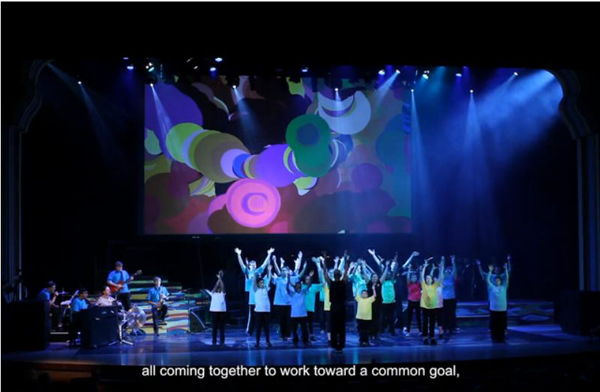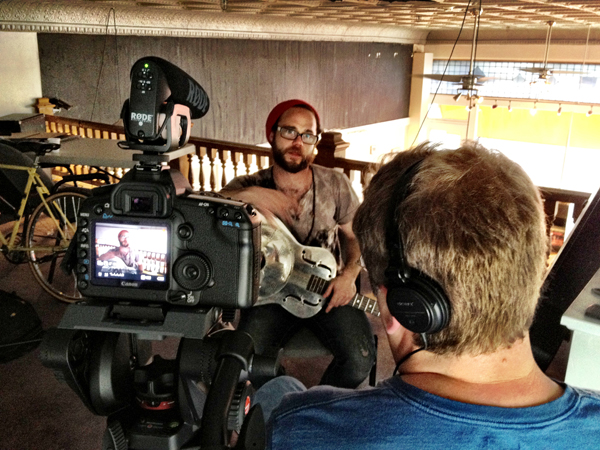LIVE ART: Two Filmmakers Capture Life-Changing Theater Education in a Crowd-Funded Documentary
SPARC's LIVE ART combines two brilliant and ambitious ideas: to create "a 20-week inclusive performing arts educational experience for children with and without developmental disabilities and hearing impairment," culminating "with these students performing on stage alongside some of Virginia's best professional musicians"; and to bring in a skeleton film crew to document not just the event itself, but the entire 5-month teaching, development, and rehearsal process in a documentary that is now being crowd-funded to completion.
Finding the Focus
Just as LIVE ART itself took some time to come into focus, so did the documentary. "When we first started talking to them," Gaff recalls, "they weren't really sure what it was going to be. It was developing. They knew that there were a lot of talented people in the area, in terms of teachers and choreographers and so forth. But they really didn't know what they were getting into until they started the classes. And they quickly realized that it wasn't so much the performance that was important; it was what was going on in the six months of rehearsals and classes. That's where sort of things started really happening that were really interesting stories. And then it was the kids, the interactions we had with the different kids. It was the experience the teachers were having. It was the experience that the parents had when they would come and watch the classes. Everybody went through some changes and a lot of personal growth throughout those six months."

For the filmmakers, producing a documentary of this scope meant struggling to identify the right threads to follow and the right direction for the film. The challenge began with the sheer volume of footage they accumulated. "We actually shot a lot more than we thought we ever would," Montgomery says, "because the stories were immense. Every day we'd go into the classroom and something would happen that would just blow us away. And we'd feel like that if we weren't there next Saturday, then we would miss something incredible. And that happened almost every class."
"We needed to be there all the time because there could've been a board meeting that had some really great stuff, or a meeting with the teachers," Gaff says. "We even went to individual student meetings where they met the instructors for the first time. And soon we started shooting some of the students in other parts of their lives, like in school, different related organizations. We started interviewing people who were experts in education with kids with autism or deaf and hard-of-hearing people."
Beyond Special . . . a LIVE ART excerpt from Martin Montgomery on Vimeo.
Conceptually, the film began to come into focus as Montgomery and Gaff chose a half-dozen students to follow closely, but that approach itself suggested multiple directions. After identifying the students they wanted to focus on, Gaff says, "We went to their school and shot some things,talked to some of their teachers. We did a little more deep digging up front and then just more interviewing. We wanted to broaden the scope of what the story was. We didn't want it just to be about the event itself or the class. We wanted to have sort of a bigger, kind of broader impact or reach."
This approach led them to interviews with experts in various fields, such as faculty at the Faison School autism center in Richmond, a SPARC and LIVE ART partner. "So we started investigating more, pursuing questions like, ‘What is life like for an autistic child or for parents of an autistic child?' Or ‘What is life like for a child who's deaf or hard-of-hearing, in terms of their social life? How do they find their place in the world, and what are some of the typical roadblocks that this event would address?' So it got pretty interesting and it got pretty big. And now we're sitting on hundreds of hours of footage because of it."

As compelling and informative as the footage this approach yielded turned out to be, ultimately, Montgomery and Gaff decided that it might not provide the best reflection of LIVE ART's character and mission. "We were focusing so much on the disabilities and trying to define them and figure out how the SPARC staff were having to change their teaching methods for these kids, we were actually defeating the purpose of LIVE ART: making art inclusive," Montgomery explains. "This project was all about acceptance and tolerance. So why should we focus on the disabilities?"
After this epiphany, the film started taking shape. "It started to become a documentary about art, about kids being kids and being able to let go through whatever forms of artistry that they want to be a part of," Montgomery says. "It's also about teachers who did not have a special needs background learning to work with teachers that do have special needs backgrounds, and how the two of them can bridge their two different teaching methods to really help all the kids in the classroom."
As they sorted out these issues, Montgomery says that he and Gaff learned an "eye-opening" lesson about making documentaries: "As a storyteller, it's important to not get fixated from the very beginning on the angle that you feel like you need to pursue, but to be open to what is really there and what is really going on."
Related Articles
For Altair and humanstory, the name of the game in college sports web shows is storytelling, and their theme-driven style is getting them lucrative gigs with top college programs.